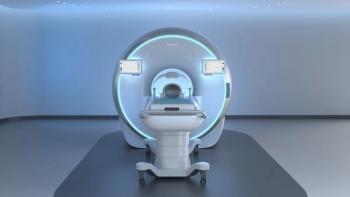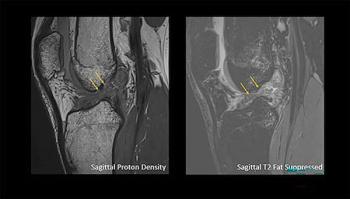
System enhancements deliver unprecedented x-ray performance
Eyeing a digital radiography market that seems to be growing in popularity, manufacturers unveiled a variety of products and works-in-progress during the RSNA meeting. Most were configured to work easily with PACS, providing the foundation for vendors'
Eyeing a digital radiography market that seems to be growing in popularity, manufacturers unveiled a variety of products and works-in-progress during the RSNA meeting. Most were configured to work easily with PACS, providing the foundation for vendors' claims of their ability to increase workflow and cost-efficiency.
Capturing considerable interest was Swissray's work-in-progress ddRRealtime, which the company developed to extend the clinical capability of its installed fleet of direct digital radiography systems. The technology delivers high-resolution digital radiographs at near-fluoroscopic frame rates, enabling rapid skeletal surveys as well as joint motion and other kinematic studies. Key features include 15 images per second, high-resolution digital radiography, CMOS (complementary metal-oxide semiconductor) technology, and 12-bit digital output.
Canon Medical Systems
A division of Canon USA, Canon Medical provides flat-panel DR systems for general radiographic applications. New products include portable and mobile DR systems for bedside applications.
- CXDI-31 flat-panel cassette-type sensor, a portable DR sensor, has been cleared for marketing. It incorporates Canon's amorphous silicon technology to provide high-quality diagnostic images and effective on-demand network distribution of captured image data.
- CXDI-50G is a portable digital radiography system designed for diverse applications, including trauma and bedside exams. The system combines a large imaging area with lightweight design to extend the range of radiographic exams using DR.
CMT Medical Technologies
The Israeli company specializes in low-cost solutions for x-ray applications. Including all its products in radiography/fluoroscopy, angio, and radiography, CMT claims more than 2000 clinical installations worldwide.
- SmartRAD debuted, featuring Thales' Pixium 4600 flat-detector technology in a single- or dual-detector configuration. The digital imaging chain is available as a retrofit for existing x-ray systems or as a digital subsystem for OEMs to build into their own equipment. SmartRad has been cleared by the FDA and will be commercially available in mid-year.
Eastman Kodak
Through the years, the Kodak name has been associated with both consumer photography and medical imaging. Today, the company's Health Imaging Group is a world leader in developing, manufacturing, and marketing advanced imaging products ranging from analog to digital.
- DirectView CR 500 offers sophisticated image processing and excellent image quality that can increase productivity. The system processes more than 60 plates per hour and provides preview images in less than a minute. Related systems include the CR 850 and 950. Shipping of the 500 has begun.
- DirectView DR 7100 enables high-quality imaging for table, upright, and extremity exams. Independent movement of the tube and bucky assembly permits flexible patient positioning. The detector can be removed and positioned for extremity and upright exams. DR 5100 is designed for chest and other applications.
Edge Medical Devices
Edge manufactures a series of flat-panel digital x-ray detectors used to upgrade screen-film systems to DR. SMART (scanned matrix array readout technology) is the cornerstone of a product portfolio populated by economically priced DR equipment. Digital detector products in single- and dual-digital bucky configurations are available through dealers and OEM sales channels.
- Quix-FP 100 Basic Kit was designed exclusively for OEMs that are developing new DR systems using Edge technology. The kit, which is awaiting FDA clearance, features a Quix flat-panel detector, frame grabber/controller card, and software development kit. It eliminates the need for detector-specific image processing in order to minimize time to market for OEMs.
- Primo is a thin-profile Quix-DB digital bucky with Quix-FP detector, GridSafe grid handling system, and detector-integrated five-field automatic exposure control. Primo-I includes a single digital bucky, while the Primo-II features a dual-bucky design for integration into new or existing wall stands and tables.
Ferrania Imaging Technologies
The privately owned Italian company is jockeying for position as a global provider of PACS and digital radiography.
- LifeInVision DR 961, built around a 43 x 43-cm amorphous silicon detector, was introduced at the RSNA meeting. The wall-mounted U-arm is designed specifically for imaging the chest, spine, and extremities. The system has an integrated operator console, which displays a diagnostic image less than five seconds after data capture. The DR 982, a robotically controlled general radiography system, and DR 942, a variable focus chest system designed to image the extremities, skull, and spine, round out Ferrania's LifeInVision digital radiography portfolio.
Fujifilm Medical Systems
Active in film as well as the digital environment, Fujifilm Medical Systems has migrated expertise from its photo film division to digital image analysis, evaluation, and processing. Its concept of image intelligence has evolved into image processing technologies that maximize the use of Fuji CR products.
- Fuji's XG5000 multiplate reader can process up to 165 imaging plates per hour. Its four-cassette stacker design is innovative, and a unique cassette slot design features independent drives to maximize redundancy.
- Velocity-T is a cassetteless digital x-ray system featuring Fuji's patented HD Line Scan technology. With an average throughput of 140 images per hour, the system can make a fully processed image available in nine seconds. Velocity-U for chest and upright exams has similar capabilities.
GE Medical Systems
Advances in digital technologies have created new opportunities for the detection of lung cancer. GE Medical sought to capitalize on these opportunities with software developments affecting its Revolution XR/d platform.
- Dual energy subtraction was showcased as the means for digitally removing bones to uncover lung cancers that might otherwise escape detection. The technology was presented as being particularly valuable in distinguishing benign from malignant nodules.
- RapidScreen Digital (see "CAD makers explore new market niches," page 6, Deus Technologies) was displayed as the means for helping radiologists detect early-stage lung cancer. The computer-aided detection software analyzes 87 characteristics indicative of lung cancer, automatically highlighting suspicious areas on the digital image and improving sensitivity by more than 20%.
Hologic
Hologic has changed its focus in recent months to concentrate more on women's healthcare. The company continues to work on DR technology, however.
- Emphasis has shifted to the supply of DirectRay detectors to makers of end-user equipment and away from the sale of the company's own DR equipment.
InfiMed
The company offers digital image acquisition, processing, and review solutions for DR, as well as x-ray fluoroscopy, angiography, and cardiac cath. Systems can be used either as retrofits to update existing rooms or in new or refurbished rooms.
- Addressing customer demand for interoperability, InfiMed successfully tested its PlatinumOne and StingRay DR products with several PACS vendors, including Fuji, e-Med, InteleRad, Vista, IDX, Medical Manager, and Agfa. Such interoperability is necessary when interfacing legacy systems with new digital units and PACS as part of efforts to improve overall productivity and efficiency, according to the company.
Orex Computed Radiography
Orex develops desktop distributed CR systems that provide image acquisition, processing, and display. The company also offers a connectivity solution that includes a comprehensive suite of software applications.
- Orex ACLrt is an automatic cassette-loading CR system for portal imaging in radiotherapy. The product was designed to capture high-quality megavoltage images for treatment verification and kilovoltage images for treatment simulation. The system comes with a CR laser scanner, diagnostic cassettes for use with treatment simulators, specially designed portal cassettes for use with linear accelerators and Cobalt-60 units, reusable phosphor plates, radiotherapy software, and PC-based review stations.
- The ACLxy scanner is a compact, lightweight, affordable CR scanner that processes up to 150 plates per hour. It addresses a broad spectrum of applications through a wide selection of optional features and accessories. Key features include normal- and high-resolution modes ranging from 5 to 20 pixels/mm and regular and low-dose applications with speed equivalent to film ASA 100, 200, and 400. Acquisition matrix can be configured at 2000 x 2500 or 4000 x 5000 pixels.
Philips Medical Systems
Film-based and digital systems offer a range of price points and capabilities in Philips' radiography portfolio.
- CR solutions showcased included the single-place PCR Compano, PCR Corado featuring 165 plates per hour throughput, and PCR CoximaX, which has the same functionality as the Corado but also offers double-sided readout of small imaging plates, resulting in a 50% increase in DQE (detective quantum efficiency). CR systems can be configured to work in concert with the company's DigitalDiagnost flat-panel system.
- DigitalDiagnost is a multipurpose single-detector system based on an amorphous silicon detector. The system enables overtable exposures and includes a flexible detector carrier mounted on a movable column.
Siemens Medical Solutions
Automation is a key component in Siemens' attempts to improve efficiency.
- Axiom Aristos MX, a multipurpose digital system for routine, trauma, and orthopedic examinations, is intended primarily for hospital radiology departments and private practices with high patient throughput and standardized applications. The system, launched at the RSNA meeting, incorporates robotics that eliminate manual procedures such as centering the x-ray tube to the table-based receptor stand. The platform can be reconfigured as the upright Aristos TX, which is dedicated to chest studies, or the ceiling-mounted Aristos VX. All feature a Trixell Pixium amorphous silicon flat detector measuring 43 x 43 cm.
- Axiom Aristos FX, introduced at the 2002 RSNA meeting, was showcased as a counterpart to the MX featuring a digital detector that can be unlocked from the bucky table. The system can handle routine clinical procedures from thoracic to extremity work, as well as ER, trauma, and pediatric applications.
Swissray International
Swissray helped pioneer DR with its CCD-based direct digital radiography systems. The company prepared to expand its digital capabilities with a work-in-progress CMOS detector capable of generating 15 high-resolution radiographs per second.
- ddRRealtime, the work-in-progress CMOS technology, is being groomed for integration into new systems and as a retrofit for currently installed ddR products. Applications include joint motion and rapid skeletal surveys in trauma patients. FDA clearance is expected this year.
- IGS1000H mobile table with elevating top targets all radiography markets and clinical applications. The product is available worldwide.
Toshiba America Medical Systems
Seeking a middle ground between conventional and digital imaging, Toshiba ventured a new platform for general radiography systems that supports both types of configurations.
- T.Rad Plus debuted as a platform for film-based as well as digital radiography. The T.Rad series can be equipped with one or two film buckys or DR panels. The flat detectors provide a 17 x 17-inch field-of-view. The system can be configured with floor- or ceiling-mounted tube support. Electronically controlled, barless tomography can be incorporated free of mechanical couplings for easy access to the patient.
Newsletter
Stay at the forefront of radiology with the Diagnostic Imaging newsletter, delivering the latest news, clinical insights, and imaging advancements for today’s radiologists.




























